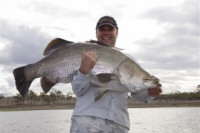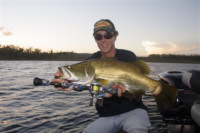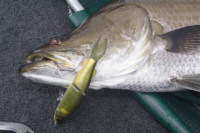|
BIG
BARRA, THE ONE PERCENTERS by Jason Wilhelm
|
I
guess its human nature to blame everything else except your own
shortfalls when measuring the results of your last trip to a dam
like Awoonga.
Bad weather, windy conditions and a falling barometer become the
catchcry when we fail in our fishing endeavours, but realistically
is there something else we have overlooked?
I have no doubt those abovementioned variables can make things
hard on their very own, but how do you explain a fishery that
delivered everything promised and more last time, yet failed to
deliver the next visit?
Awoonga
dam really hit her straps mid 2005. Word travel fast, just about
every fishing scribe in the industry made the trip and reported
it, and the bush telegraph was in overdrive.
Some really good information can come out of all that exposure,
but the downside is that after a few trips and a dozen metre fish,
the overnight experts multiply weekly.
I firmly believe this is one of the reasons impoundment Barra
fishing is perceived as a tricky game, and why many visiting anglers
miss out.
In all reality, there are no real tricks, just some smart thinking,
some persistence and hard work.
I'm also of the opinion that it is easy to misinterpret the fact
that these fisheries are easy. They are not.
They do have days when they go ballistic, but I'd fancy my shot
at Powerball over holding out for that special day.
|
Getting
back to how fishing changes, if you delve into the relatively
short history of impoundment Barra fishing, you will see
an uncanny parallel in the Awoonga and Peter Faust dam fisheries.
That parallel is that both dams went through an almighty
boom, followed by what many call a progressive bust.
Believe me, Faust, an almost forgotten mighty fishery is
still very much alive and kicking when it comes to all time,
classic barra fishing.
It has, just like Awoonga, fallen off the radar a little.
Awoonga, is still every bit as awesome as it ever was, and
like most of the other locals at Proserpine and Gladstone,
I'm quite happy how things have panned out.
Going
back to early 2000, I clearly remember how Faust ignited
the impoundment barra fuse.
Every magazine in the land had giant barra on its covers,
feature stories, glossy centre spreads and tales of wipe-outs
and triumph.
Faust arrived in a hurry, but it fell off the masses radar
quicker.
|
|
|
|
Making
long, wind assisted casts will increase your catch
rates dramatically
|
|
Why?
Well………….depending on who you talk to, it's
either been fished out, or it's just plain too hard to catch them
any more.
Funnily enough, my good mate Lindsay Dobe, who's been guiding
clients onto impoundment barra for longer than anyone else in
the land, rarely misses out on putting punters onto fish at Faust.
Then Awoonga fell into the doldrums, apparently for the same reasons,
fished out or too hard.
The
change
So, what has changed? What has happened for the fishing to be
harder than what it was? This question is much easier to answer
than you probably think. Has the fishery changed? Yes defiantly.
Have the fish changed? Absolutely! Weather patterns, the drought,
angling pressure, speedboats and competitions all add to the equation.
They have all shaped the fishery in some way. Lets look at how.
Weather
The weather is way outside human control, so we just have to live
with what's being dished out. It's fair to say that each year
we seem to be losing the seasons, and weather cells move through
unseasonally and the big drought marches on. Falling water levels,
a littoral zone that can't establish combined with weed banks
collapsing, all is conspiring to make life hard for resident Barramundi.
Climate change is a Pandora's Box that I'll leave alone here,
so we will move onto the fish.
Fish.
Have they changed? Yes for sure. How? Well, in many ways.
Firstly, when the Awoonga boom hit, it's fair to say that it was
a dam full of uneducated fish cruising the fringes and open water
in search of a food source. They had not been exposed to any serious
angling pressure. This also coincided with favourable long periods
of extremely stable weather, which is far more important than
people realise. Another very important factor was that all that
stable weather boosted the productivity of the natural food chain
and infact peaked during this period. By that I mean that the
full benefit of the dam top up courtesy of cyclone Benny had reached
its potential.
The mega amounts of nitrates and phosphates washed in had seen
an unprecedented level of phytoplankton explode. In turn the Zooplankton
which feeds on phytoplankton multiplied, and then the Boney bream
hit their straps feeding on the Zooplankton.
I distinctly remember on clear water days seeing the whole bottom
shimmer in most bays on Awoonga. The schools of Boney Bream would
totally black out my sounder at times as well, even out in 80
feet of water! The Boney Bream numbers were simply amazing, and
it was obvious how well the food chain was thriving.
The apex predator, Lates Calcarifer, was in a good paddock.
During
this period the ease at which metre plus Barramundi were caught,
especially trolled fish was starting to make me feel ill in the
stomach. There's no doubt a lot of metre plus stocks were knocked
around, it started to become a frenzy. I know and respect the
fact that it's a put and take fishery, but some people misunderstood
the word "take".
From pig food to garden fertiliser, many magic metre plus Barra,
a valuable iconic Australian sportfish, had befallen a terrible
tragic end. I and other regulars were starting to worry.
Fortunately, Mother Nature took control and brought back the South
Easters. This in turn made the fishing harder, cooled water temperatures,
and also dissipated hot bites.
To coincide with the weather change, a distinct period of "very
tuff fishing" had arrived. Were all the fish caught? What
had happened?
|
Numbers
Considering 3 million fish have been released in Awoonga,
and what I see on my Lowrance sounders every trip, the numbers
of fish in Awoonga is still staggering. So what's happened
if the fish are still in such big numbers?
Getting
back to how they have changed, a lot of good fisher folk
have really focussed on their catch and release practises,
and subsequently a high percentage of barra returned to
the water have gone on to survive, as well as learn.
Barramundi, wild or impoundment, are probably not the intelligent
fish you might think they are. They can be difficult to
catch, yes, but not because they are a smart species.
I can distinctly remember watching Malcolm Douglas catching
Barra after Barra in the top end on a piece of tin foil
and a bent nail. Some of those fish he had just released.
That's no smart fish! I've also caught the same Barra I
released ten minutes earlier while fishing in Arnhem land,
as well as a repeat capture in the dam.
|
 |
|
This
124cm Barra ate a stiffy bony bream fished suspended
in 18 feet of water
|
|
But
what Barra lack in the smarts department, they well and truly
make up when it comes to survival. There's certainly no doubt
that Barramundi, like many other species become very wary or even
suspect, particularly in fisheries that see a lot of angling pressure.
Impoundments
fit in that category, and its fair to say that during the peak
times at Awoonga, when 150 plus boats were roaring around, sounders
pinging, electric motors humming and hulls were banging the fish
were learning. Add to that the fish that were hauled aboard then
set free, its really not that hard to see that the fish are going
to wise up.
In all reality though, the dam's population of Barramundi are
just trying to survive. They are not trying to learn algorithms
or how to out think you, its purely evolving instinctive survival
mechanisms, triggered by human interaction. If we as humans never
fished for them, its fair to say that they'd be a sorry bunch
probably caught every cast.
So,
what I am saying is at the very least, Barramundi are able to
associate un-natural sounds, sights and smells with danger, and
I expect far deeper than we have previously imagined. They may
also wary of frequencies, weather it be sounders, reverberation,
light reflection, sounds from heavy braids and perhaps even noisy
reels.
What
hasn't changed?
We have looked at what's changed in the fishery, so now I'll focus
on what hasn't changed.
Let's look at the angler. Has he or she changed?
Well some have, very few actually, but the majority haven't. They
have turned up in their droves; gear rigged the same as last time,
the same techniques, the same attitude and the same plan of attack.
And why not? It worked last time right?
But as the trip wears on, few fish are caught, and the shoulders
drop. I can pick it a mile away at the ramp, and can often tell
whether its worth while asking how an angler faired. The body
language tells the story loud and clear. It's easily been the
most common sight at the ramp these past 18 months. The fish have
wised up, but the angler has not. It's far easier to blame the
weather variables or a flogged out fishery than addressing the
problem. Instead of searching for the answers, we as humans tend
to look for a way out. The best anglers in the land don't.
Tactics
The most important step in your preparation is to cover your bases.
Don't limit yourself to one style of fishing. At times suspending
lures are the go, other times reaction baits like slick rigs are
the stand out. Other times large bibbed deep divers will take
fish when all else fails. Be prepared to find what the fish wants
and where. You'll know when you get it right. Finding the specific
depth at which the fish are congregating at and presenting a lure
continually will see results. Do what it takes to catch them,
even if it means learning a new method, or one you know little
about. It's the only way to learn.
|
Lures
The abundance of barra lures and plastics hardly make the
choice easy, but be realistic and understand that Barramundi
really are not that fussy.
I keep my choices of plastics down to the squidgy slick
rig range, these plastics are by far the best lure at covering
water, and the results speak for themselves. If there's
an active Barra around, the slick rig will undo it.
The same rules apply to hard bodies. The usual suspects
are all still great fish takers, the Classic range, the
Bombers, the Scorpions, as well as a few new lures that
have hit the shelves in recent time. One
of these lures, the Stiffy Boney Bream, has been a standout.
This lure was designed by Bushy, and after comprehensive
testing on Awoonga by the Stiffy crew it's now in full production.
I was lucky enough to be involved in the trial and testing
of this lure, but it's certainly not why I'm mentioning
it here. It comes standard with owner rings and hooks; the
Boney bream is a great big fish lure certainly worth a look.
Another
thing to keep in mind is using lures that are different
to what's used every day. There's no doubt that something
different raises interest amongst the resident barra, it
makes sense when you think about it. You've all heard stories
about the guy who turns up with the cheap lure from the
$2 bin and catches barra with it? Yep, something different.
Suspending lures are also a key, X-Raps, storm suspending
shads and lures you can customise yourself with sticky weight
or larger owner hooks to suspend can be lethal on their
day, and it may be the difference between a wicked session
and a doughnut.
Jointed lures like the Evergreen ES Drive also have their
place on impoundments, they are not cheap but on their day
are hard to beat.
|
|
|
|
Lures
that are a little different to what everyone uses
can be an advantage,
a jackal swim bait undone this Awoonga Barra
|
|
Braids
Twenty to 30 pound will see most fish landed and natural coloured
braid is also something to consider. If you're fishing timber
structure then 50 pound is smart practise. Bright coloured braids
are not flash in my opinion, dye it yourself if it's not to your
liking.
Leaders are also important consideration, and in clear water dropping
right back in leader size will get you more bites. The downside
of that is you will land less fish, but you need to hook them
first right?
Generally I don't use anything under 80lb, I personally don't
like fluorocarbon in heavy sizes because of knot strength.
Leaders are again personal choice, some use knotted style leaders,
wind on pre-made leaders, heavy braid leaders and others are happy
with single strand mono.
There is no 100% guarantee when it comes to leader systems, I'm
quite certain there isn't a fish swimming around that's harder
on terminals than barramundi.
The scissor action and raspy lips and mouth mean high abrasion
in a short space of time, especially if you are fishing a tight
drag.
Distance
Casting distance is a critical factor. The simple fact is the
further you can cast, the more strikes you will get.
Not just because the lure is covering more water, but because
it will enable you to stay well off the weed edges and drop offs.
Sitting on top of weed beds will have fish scattering in every
direction, those fish are the ones you want to catch.
Stealth
This is a priority. Sound travels at 1500metres per second underwater,
so every noise you emit carries far greater than you think. Don't
announce your arrival by banging hatches or gear against the boats
hull. A super quite approach will serve you well, and combined
with casting distance and tackle choice, this alone will see a
marked improvement in your catch rates.
My Minn Kota electric is up there with my most prized possessions,
its faultless silent operation means I can focus on the fish,
whilst the Minn Kota enables me to cover ground in a silent manner.
Moving around slowly and quietly is the key, well away from other
boats who may not be observing the same critical factors that
you are is good practise.
Sounders
I run a Lowrance LCX-37c on my console, and an X510c on the bow.Having
a good sounder that you truly understand is vital to any fishing
application, impoundments are no different. Everyone has personal
preferences when it comes to sounders; there are many good products
on the market. Whatever you choose, make sure you take the time
to understand its functions and understand what the screen is
displaying. Being able to decipher the data displayed in front
of you adds a very important final piece to the puzzle.
You need to understand what a barra looks like compared to other
returns on your set. Catfish, Mullet and other baitfish all throw
different returns; you need to know what is what. My Lowrance
sounders are easily my most valued possessions. They are state
of the art fish finders which I have incredible faith in, and
although not cheap they are worth every cent.
I categorically know what Barra look like on my screen; this information
can easily be the difference in how you fair on the water. Selective
use of sounders is also important in my opinion. Yes, I've heard
that fish cannot hear the frequency sounders operate on, but I'm
not sold. If you're in familiar territory, anchored or know there
is fish in the area, then why transmit? Keep the peace, so to
speak.
The
difference
As you can see, the things that will make a difference to your
overall results are not exactly super hi tech, or even rocket
science. Its just smart angling practices, that if applied to
your local "fished out" areas, you just may find out
it's not fished out at all. More likely a wised up fish population.
None of the info shared here is anything new or tricky. The factors
I have highlighted often get overlooked in favour of less important
practises like lure colour.
It's what I call the 5 percenters. The small but important factors
that combine and make all the difference!
Jason
Wilhelm
Barra
Madness Fishing Tours www
email







